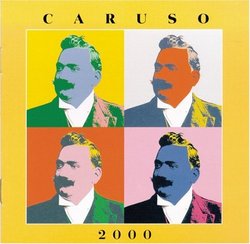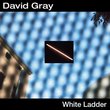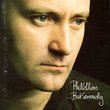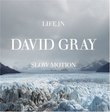| All Artists: Giuseppe Verdi, Fromental Halevy, Giacomo Meyerbeer, Jules Massenet, Friedrich von Flotow, Amilcare Ponchielli, Ruggero Leoncavallo, Giacomo Puccini, Gioachino Rossini, Enrico Caruso Title: Caruso 2000 Members Wishing: 0 Total Copies: 0 Label: RCA Release Date: 2/8/2000 Album Type: Original recording remastered Genres: Pop, Classical Styles: Vocal Pop, Opera & Classical Vocal, Historical Periods, Modern, 20th, & 21st Century Number of Discs: 1 SwapaCD Credits: 1 UPC: 743216976621 |
Search - Giuseppe Verdi, Fromental Halevy, Giacomo Meyerbeer :: Caruso 2000
 | Giuseppe Verdi, Fromental Halevy, Giacomo Meyerbeer Caruso 2000 Genres: Pop, Classical
The idea behind Caruso 2000 is actually not new. In the early '30s, RCA rerecorded some of the legendary tenor's acoustic recordings with newly added orchestral accompaniments, to rather crude results. With today's compute... more » |
Larger Image |
CD DetailsSynopsis
Amazon.com The idea behind Caruso 2000 is actually not new. In the early '30s, RCA rerecorded some of the legendary tenor's acoustic recordings with newly added orchestral accompaniments, to rather crude results. With today's computer know-how, one can carry out this concept with infinitely more finesse and musicality, as the present release proves. What we have are some of Caruso's most famous and memorable sides, with the voice's overtones pretty much intact, minus the shellac surface noise. Likewise, the blatty orchestras are virtually rubbed out, replaced here in new performances by the Vienna Radio Symphony. It's amazing how accurately conductor Gottfried Rabl pinpoints accompaniments around Caruso's very personalized rubatos. In fact, Rabl sometimes anticipates the singer's special effects rather than reacts to them. The basic problem is that you don't get a tangible sense of Caruso's projection. Compare, for instance, the 1907 "Vesti la Giubba" from I Pagliacci (track 17) to its reconstituted counterpart (track 13). The unadulterated recording reveals the voice in proportion to the blatty orchestra in a finite space, with no dial twiddling or body miking to beef things up. In the new version, voice and orchestra are miraculously matched, yet don't blend. A vocalist will normally adjust his or her voice to the environment, but singers can't do such things when they're dead. Still, a release like this will surely instigate Caruso awareness among budding opera fans, just as Ted Turner's colorized films make classic movies palatable to viewers allergic to black and white. --Jed Distler Similarly Requested CDs
|
CD ReviewsPrepare for a Suprise JJD | New York City | 02/25/2000 (5 out of 5 stars) "I just bought this disk. I bought the NY Times on the way home. Had I read the idiotic review by Allan Kozinn (Sunday, feb. 20), I probably would not have bought it. What a loss that would have been. In this disk, several of Caruso's recordings have been matched with high quality stereo recordings of an orchestra. True, if you listen carefully, the sound quality of the vocal is noticeably inferior to that of the orchestra. BUT - all of a sudden, you have the impression of Caruso on stage in an opera house. The stereo (really mono for him) image places him center stage with the orchestra spread out. What a different feeling from the original recordings (I have the complete set of them and have listened to them all) which give the impression of a cramped studio where the orchestra (if there was one) was cramped in front of the recording horn with winds (even tubas) replacing many of the strings (since they projected better into the recording horn). One small caveat: the voice comes across with a bit more sheen in the complete set of Caruso recordings released a few yeras ago. Nevertheless, for those of you who have heard his recordings, sit back, do not concentrate on the sound quality difference between voice and orchestra. You will hear Caruso totally differently. Kozinn's Times review suggests the producers will be putting out a Caruso/Elvis duet next. This is completely unfair to those who have sensitively matched the orchestra to the voice. This is a work of art of sorts, not a defacement. If you like opera singing and Caruso, get this disk" Caruso as you've never heard him before pm444 | Okemos, MI USA | 02/26/2000 (5 out of 5 stars) "The idea of creating on disc a performance that never took place in real life may cause purists to wonder. But just listen to one of the tracks here and you'll get a good idea of what this CD offers. First of all, you hear Caruso's voice without the intrusive surface noise found on most other recordings. But even better, you hear him in the context of a full orchestra. Instead of minimizing the impact of the voice, the orchestral accompaniment highlights it, and even diminishes the "tunnel" effect of the old recordings. It's a perfect starting point for someone who has not yet heard this incredible voice, and an excellent addition to an existing Caruso collection. Not to be missed!" I really liked it, maybe more than I expect to Nick | UK | 10/04/2000 (4 out of 5 stars) "I heard this CD reviewed on BBC Radio 3's `CD-Review' and immediately logged on to Amazon to buy it! To `re-master' the old shellac recordings of Caruso and add a modern orchestral accompaniment seems impossible, but the people at BMG have done it very well. The Vienna RSO do the music justice and, of course, Enrico is superb.If I have any criticism, the orchestra is a little too forward sometimes - it sounds like Caruso is singing from outside the room - but don't that let that put you off. This is a superb and fun CD - not for the music purists, but if you want to hear Caruso to the best standards that modern technology can offer, this is for you."
|

 Track Listings (17) - Disc #1
Track Listings (17) - Disc #1








